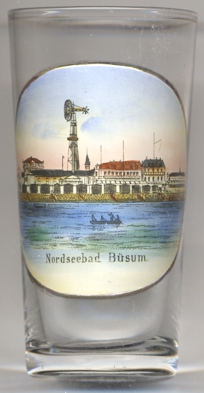

|
| DEUTSCHLAND | GERMANY |
| Bundesland: Schleswig-Holstein | |
| Kreis: Dithmarschen |
Büsum is situated at the North Sea coast of western Schleswig-Holstein, about 18 southwest of Heide, the administrative centre of the district Dithmarschen, and about 85 km southwest of Kiel, the capital of Schleswig-Holstein. The municipality has a population of about 5,000 (2022).
 The first documented mention of Bivsne (as an island) dates from the year 1140. The island's name on medieval documents changed several times from the
original Bivsne (1140) to Busin (1208), Busen (1281), and Buzen (1447). During medieval times, Büsum was an island with three
villages, Süderdorp, Middeldorp and Norddorp. Devastating floods in 1362, 1436, and 1570 drowned most of the island and destroyed the two settlements
Süderdorp and Middeldorp. The former Norddorp nowadays forms the old core of the town Büsum. In 1585, the island was connected with the mainland
through the building of a dam. Subsequent deposits of sediment by the sea created new land, which was further secured through dikes. Storm floods continued to
take their toll such as in 1634, 1717, and for the last time in 1825. Since then, the improved dikes have been able to protect the town from storm tides. The
island of Büsum was originally beholden to the bishopric of Hamburg and Bremen before Dithmarschen became
a confederated peasant's republic. From 1559 until 1867, Büsum (and Dithmarschen) were Danish territory and subsequently became part of Prussia. Since
1818, Büsum has been used as a spa town visited for the healing effects of the seawater and the mudflats of the Wadden Sea. It gained official 'Nordseebad'
(North Sea spa) status in 1837. To accommodate spa guests, Büsum was connected to the railway network by the Heide–Büsum railway in 1883. After
World War II, Büsum was part of the British Zone until 1955. Today, Büsum is a popular summer vacation spot for families and day trips from
Hamburg.
The first documented mention of Bivsne (as an island) dates from the year 1140. The island's name on medieval documents changed several times from the
original Bivsne (1140) to Busin (1208), Busen (1281), and Buzen (1447). During medieval times, Büsum was an island with three
villages, Süderdorp, Middeldorp and Norddorp. Devastating floods in 1362, 1436, and 1570 drowned most of the island and destroyed the two settlements
Süderdorp and Middeldorp. The former Norddorp nowadays forms the old core of the town Büsum. In 1585, the island was connected with the mainland
through the building of a dam. Subsequent deposits of sediment by the sea created new land, which was further secured through dikes. Storm floods continued to
take their toll such as in 1634, 1717, and for the last time in 1825. Since then, the improved dikes have been able to protect the town from storm tides. The
island of Büsum was originally beholden to the bishopric of Hamburg and Bremen before Dithmarschen became
a confederated peasant's republic. From 1559 until 1867, Büsum (and Dithmarschen) were Danish territory and subsequently became part of Prussia. Since
1818, Büsum has been used as a spa town visited for the healing effects of the seawater and the mudflats of the Wadden Sea. It gained official 'Nordseebad'
(North Sea spa) status in 1837. To accommodate spa guests, Büsum was connected to the railway network by the Heide–Büsum railway in 1883. After
World War II, Büsum was part of the British Zone until 1955. Today, Büsum is a popular summer vacation spot for families and day trips from
Hamburg.
The  Büsum lighthouse is a popular landmark of the town. The first lighthouse built in 1878 was simply a lantern mounted on
a wooden post, which was fuelled by kerosene. At the beginning of the 20th century, the era of electrification began in Büsum. In 1900, the engineer
Max Gehre, a spa guest from Düsseldorf, made the first electric street and building lighting possible by building a wind
turbine. A light barrel, which he constructed, was powered solely by the waves and showed the way into the harbour for a short time. This type of lighting was
replaced in the same year by a 25-metre-high scaffolding with a wind motor that powered a powerful light bulb [This is shown on glass no. 4578, left:
background centre]. This construction was replaced by the current lighthouse, built in 1912–1913 and similar in design, although not as tall, as
the lighthouses at Westerheversand, Hörnum and Pellworm.
Büsum lighthouse is a popular landmark of the town. The first lighthouse built in 1878 was simply a lantern mounted on
a wooden post, which was fuelled by kerosene. At the beginning of the 20th century, the era of electrification began in Büsum. In 1900, the engineer
Max Gehre, a spa guest from Düsseldorf, made the first electric street and building lighting possible by building a wind
turbine. A light barrel, which he constructed, was powered solely by the waves and showed the way into the harbour for a short time. This type of lighting was
replaced in the same year by a 25-metre-high scaffolding with a wind motor that powered a powerful light bulb [This is shown on glass no. 4578, left:
background centre]. This construction was replaced by the current lighthouse, built in 1912–1913 and similar in design, although not as tall, as
the lighthouses at Westerheversand, Hörnum and Pellworm.
[https://de.wikipedia.org/wiki/B%C3%BCsum, https://en.wikipedia.org/wiki/B%C3%BCsum;
https://en.wikipedia.org/wiki/B%C3%BCsum_Lighthouse, https://www.buesum.de/buesum-erleben/poi/buesumer-leuchtturm]
![[scale]](lineal.jpg)